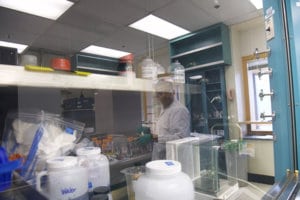Life
A Scientist With a Deep Love of Textile Mills

Samit Chevli, 43, a principal investigator at DuPont, in Wilmington, Del., June 13, 2018. Chevli is in the lab at least once a week when not traveling.
Photo Credit: Mark Makela/The New York Times
Samit Chevli, 43, is a principal investigator at DuPont, a division of DowDuPont in Wilmington, Delaware.
Q: DowDuPont makes a lot of things: food ingredients, personal care items, and polymers and fibers, to name a few products. What do you work on?
A: I’m in the industrial biosciences division, where we explore ways to bring eco-efficient products, partially derived from renewable resources like corn or sugar, to market. I work mostly on textile fibers used in carpeting and apparel, and as principal investigator I have overall responsibility for the project. I also give technical marketing presentations to companies in the United States and Europe, explaining to designers and manufacturers how the fibers will perform in carpeting or clothing. I travel quite a lot.
Q: Do you do lab work yourself?
A: When I’m here, I’m in the lab at least once a week, helping to develop and test the fibers. To make them, we use glucose derived from corn, mix it with other ingredients and let it ferment, similar to how beer and bread are made.
One of our tests involves using washing fabric samples in laundry machines that simulate washing them multiple times at home. We also use light fastness testers that replicate sunlight to see how fabrics behave when exposed to sun.
Q: What drew you to this kind of work?
A: Growing up in Surat, India, less than 200 miles north of Mumbai, I was surrounded by people with science backgrounds. My mother’s side of the family has several doctors, and there are textile entrepreneurs on my father’s side. My parents were always talking about something related to science at the dinner table. Visiting a textile coloration mill also had a big influence on me. It’s not always a pleasant environment — it’s often hot and humid, and there’s frequently an odor and water on the floor from the process, but I liked it.
I attended the University of Mumbai for a bachelor’s in textile technology.

Samit Chevli, 43, a principal investigator at DuPont, tests dyes in a company laboratory, in Wilmington, Del., June 13, 2018. Photo Credit: Mark Makela/The New York Times
Q: Did DuPont recruit you?
A: Yes. After I got a master’s in color chemistry from the University of Leeds in England, the company sponsored me for a Ph.D. there, and as I was finishing, they offered me a job that was a good fit. It wasn’t a given that I would get a job with them; if they hadn’t had an opening, I would have been out of luck. I never planned to pursue a Ph.D. — I thought I’d return to Surat in India to work at my father’s textile mill after finishing my master’s — but a door opened and I walked through.
Q: Was this your first job there?
A: For the first 15 years here, I worked with inks used in printing on textiles on quite a few applications, from T-shirts to curtains. Picture a printer 15 times bigger than a home printer. That’s what we use to print ink on large swaths of fabric. I still work with inks occasionally.
Q: What do you especially like about your work?
A: I get to work on new products, but I still like being in the mill, the customers’ plant, and piloting one of our products for them on their big dyeing machines. Recently I was in England, trying our fabric in a customer’s blended fiber carpet application. I was making sure the color was uniform throughout, which is not easy to achieve on an industrial scale. They really needed a bigger machine that would operate at a higher temperature, but I had to make it work on the one they had.
Q: Is the work challenging?
A: My friends and family think I have this great job and get to travel to cool places, but it can be very stressful. There’s constant anxiety about how the product is going to turn out. Unless you produce it on a large scale, you can never be sure, and I’ve been at customer sites where it has not gone well. Then we’re back to square one.
© 2018 New York Times News Service
